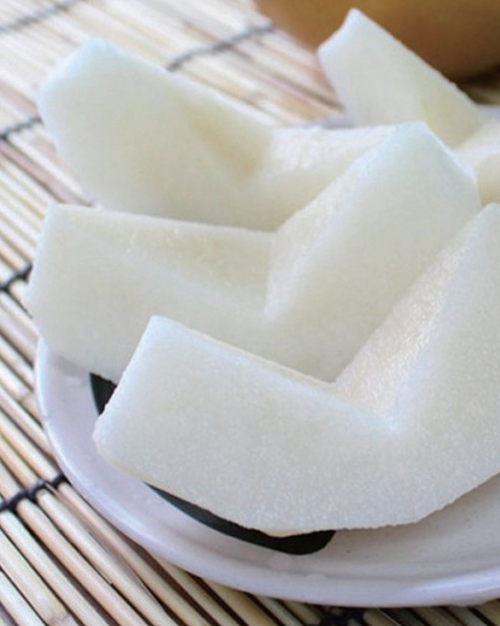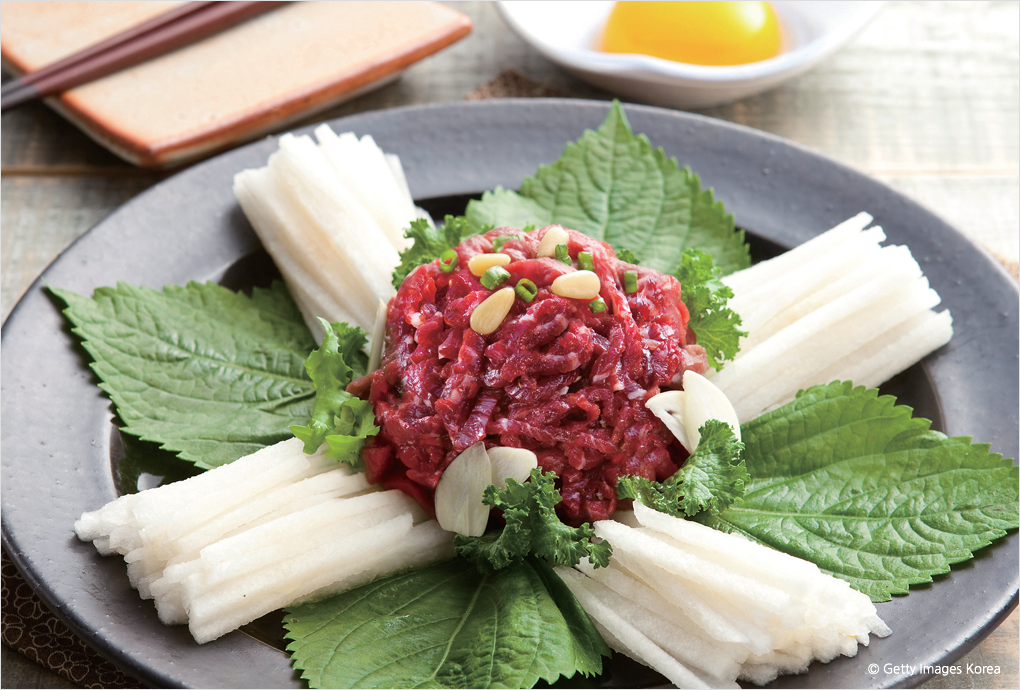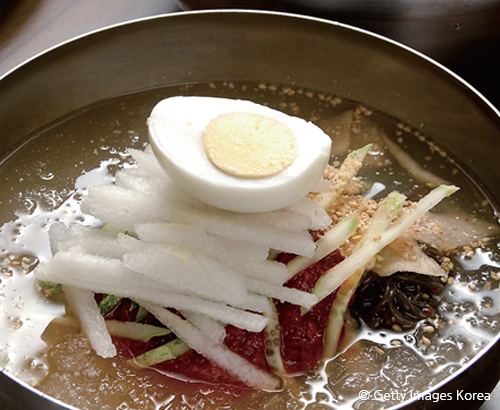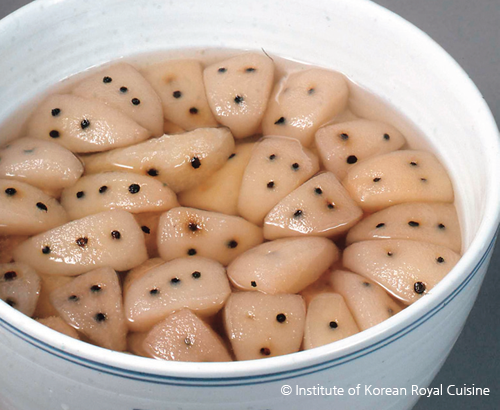Many Koreans give pears as gifts for Chuseok, the harvest moon festival. The big pear with golden skin resembling autumn leaves is one of Koreans’ favorite fruits. Pears are also used in cooking as well as traditional folk remedies. Recently, the stone cells of pears are being studied as a possible substitute for microplastics.
Pears, or bae in Korean, are so refreshing that just the thought of biting into one can almost quench the thirst. A large golden-ripe pear is sweet and juicy. Unlike Western pears that are often sold unripe due to the rigors of long-distance shipping, Korean pears can be eaten immediately after purchase.
In addition to water and sugar, pears contain fiber, potassium, vitamin C and various antioxidants. They also contain fructose and sorbitol. These can upset the stomach if consumed in large quantities, but smaller amounts can help relieve constipation. Pears have traditionally been used for constipation relief, as a hangover cure, and to soothe coughs. Recently, experts have learned that the high potassium content of pears helps adjust blood pressure.
In 2015, Korean pears hit the headlines when Professor Manny Noakes at the Commonwealth Scientific and Industrial Research Organization (CSIRO) in Australia, based on her study of pears, said that consuming a cup of Korean pear juice before drinking alcohol helps prevent hangovers.
The reason for the effect, or which components do the job, has not yet been determined, but Korean pear juice is thought to act on key enzymes that speed up alcoholic metabolism and inhibit alcohol absorption. To benefit from this effect, the pear or pear juice must be consumed before, rather than after, drinking. According to joint research carried out by scientists from Korea, Japan and the United States, however, it does not work for everybody, with differences depending on genotypes.
In the West, human body shapes are often classified as “apple type” or “pear type.” While apples are generally thicker on top and slimmer lower down, pears tend to have a bulb-like shape, the rounder part being the lower part. Apple types have a rather thick waist and carry belly fat, whereas pear-type people have a thin waist with fat concentrated in their bottoms. The apple type is more common among men, the thick waist indicating visceral obesity, a condition accompanied by high risk of some serious metabolic syndromes, such as diabetes or heart disease.
White Fruit of the Rose Family
Unlike their Western counterparts, Korean apples and pears are similar in shape. For that reason, Korean pears, or Asian pears, are sometimes called “apple pears.” These pears are usually bigger than apples and have a golden-brown skin, not the red or green skin of apples, but being round with no difference between top and bottom they are much the same shape as apples. In fact, apples and pears are closely related, both belonging to the Rosaceae, or rose family. Both originated from Eurasia and are pome fruits that develop from calyxes. But it only takes one bite to distinguish between apples and pears by their texture. One fourth of an apple’s volume is air and apples are often dry to bite, but one bite of a pear fills the mouth with juice.
Pears are often used in Korean cooking. They contain proteolytic enzymes, which break protein down to amino acids, and are therefore used to marinate beef or ribs to soften the meat. Pear is also eaten with beef tartare (yukhoe) for its crunchy texture and sweet flavor.
Garnish Stimulating Flavor

The pear, one of Koreans’ favorite fruits, is served as dessert and often used in cooking as well. It has also been widely used in traditional folk remedies to help suppress coughing, cure hangovers, and relieve constipation.
Old s show that shredded pears were used as garnish for various dishes. “A Record of the Seasonal Customs of the Eastern Kingdom” (Dongguk sesigi) from 1849, which deals with annual events and customs of the late Joseon period, says, “Japchae and pear, chestnuts, sliced beef and pork mixed with oil, soy sauce, and buckwheat noodles make a dish called goldong myeon (literally “noodles with curios”).” The 1921 edition of “Various Korean Recipes” (Joseon yori jebeop) from early modern times recommends shredded pear as a garnish for bibimbap (rice mixed with various vegetables and meat). In “Various New Korean Recipes” (Joseon mussang sinsik yori jebeop), the first color-printed Korean cookbook published in 1924, pears were one of the ingredients in japchae, a dish of glass noodles mixed with stir-fried vegetables and meat.
But the first thing that comes to mind when we think of pears is cool dongchimi (white water radish kimchi usually eaten in winter) and naengmyeon (cold buckwheat noodles). Myeongwolgwan (Bright Moon House), the most famous restaurant in Seoul in the early 20th century, had great success in introducing dongchimi noodles cooked in the way it was prepared for the Joseon royal family. A book titled “Essential Knowledge for Ladies” (Buin pilji), published in the early 1900s, introduces Myeongwolgwan naengmyeon, a dish made with noodles in cold dongchimi juice, garnished with thin shredded radish, pear and citron as well as thin-sliced boiled pork and strips of pan-fried egg, sprinkled with pepper and pine nuts.
Today, bibimbap and japchae served at Korean restaurants don’t have a shredded pear garnish, but naengmyeon and bibim guksu (cold spicy noodles) are still served with thin shredded pear on top. Adding whole pears to the juice when making dongchimi to give the white radish kimchi a fresh taste is an age-old method still used at restaurants as well as ordinary homes.
In the past, Korean pears were rough on the outside and tasted rather sour. For example, “Women’s Encyclopedia” (Gyuhap chongseo) from 1809 introduces a special dish using pear, called hyangseolgo (meaning “fragrant snow cream”), as follows:
“A hard, sour munbae [wild pear] is peeled and cut lengthwise and black peppercorns are inserted into the slices. Place the pear pieces in a pot of honey water with thinly sliced ginger and simmer slowly until the pear changes to a reddish color and the seeds soften after the honey has completely soaked into the pear. Only sour pears turn red. When using pears that are not sour, omija [schisandra berry] juice can be added. To eat with jeonggwa [dried fruits boiled in honey], the concoction should be boiled down till it hardens, but for sujeonggwa [cinnamon punch with dried persimmons], it should be boiled less so there is plenty of honey water, which is mixed with cinnamon powder and sprinkled with pine nuts.”
Wild Pear with Strong Aroma
Baesuk (cooked pear drink) is made in a similar way: black peppercorns are inserted into pieces of pear and boiled with ginger in honey water. Both dishes call for munbae, wild pears that are small, hard and sour, and are also called dolbae (stone pear). Both in the East and West, wild pears are entirely hard. Due to the stone cells that are rich in cellulose and lignin, their texture is rough like sand.
Soft, sweet and juicy pears are the result of improvement by plant breeders. Wild pears have a stronger aroma, despite being less tasty than newer breeds.
On April 27, 2018, President Moon Jae-in and North Korean leader Kim Jong-un were served munbaeju (wild pear liquor) at the banquet following their summit at the truce village of Panmunjom. The alcoholic drink was so named as it has the aroma of wild pears that grow in the Pyongan provinces in North Korea, but it does not actually contain wild pear. Even so, it is worth trying to get a taste of the wild pear from the aroma alone. On the other hand, igangju from Jeonju in southwestern Korea is popular for its rich pear taste. Pear, ginger, turmeric, cinnamon and honey are added to soju made in the traditional way by distilling fermented rice, and the mixture is left to mature.

Pear is served with beef tartare, or yukhoe, for its crunchy texture and sweet flavor.
Pears are often used in Korean cooking. They contain proteolytic enzymes, which break protein down to amino acids, and are therefore used to marinate beef or ribs to soften the meat.
Substitute for Microplastics
In the past, plant breeders tried to reduce the rough stone cells in pears toa softer texture. But it is those stone cells that are now being studied in Korea as a possible substitute for microplastics that are used as an exfoliant in cosmetics and an abrasive in toothpaste. If research goes well, the leftovers from producing pear juice and canned pears, as well as the fallen and damaged fruit that are usually wasted, could be used to help decrease environmental pollution.

Thin shredded pear is used to garnish various dishes, including cold noodles.

Baesuk, a pear drink originating in palace cuisine, is made by inserting black peppercorns into pear pieces which are then boiled with thin-sliced ginger and honey. A cough remedy, the mixture is allowed to cool before drinking.